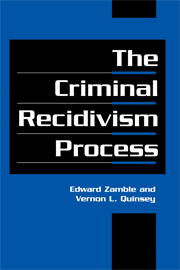Book contents
- Frontmatter
- Contents
- List of Illustrations and Tables
- Preface
- 1 Introduction: The Prediction of Criminal Behavior
- 2 The Study
- 3 Recidivists: A General Profile
- 4 Comparisons with Nonrecidivists
- 5 Comparisons across Offender Groups
- 6 Comparisons within Offender Groups
- 7 Final Considerations
- References
- Appendix: Interview Form
- Index
7 - Final Considerations
Published online by Cambridge University Press: 02 February 2010
- Frontmatter
- Contents
- List of Illustrations and Tables
- Preface
- 1 Introduction: The Prediction of Criminal Behavior
- 2 The Study
- 3 Recidivists: A General Profile
- 4 Comparisons with Nonrecidivists
- 5 Comparisons across Offender Groups
- 6 Comparisons within Offender Groups
- 7 Final Considerations
- References
- Appendix: Interview Form
- Index
Summary
in each of the preceding chapters we have considered implications of our data in context, and it would be redundant to repeat or even review that discussion here. However, there are some general issues raised by the results as a whole. This chapter is largely comprised of examination of some of the wider implications of the research reported here.
In particular, we will survey the consequences of our data in three general substantive areas. First, the results affect our theoretical understanding of the causes and maintenance of criminal behavior. Second, they also have significant implications for policies and practices in the supervision of released offenders. Finally, they hold promise for new directions in the development of instruments and procedures for predicting recidivism.
However, before discussion of those general issues, a brief reconsideration of methodological issues seems appropriate because any conclusions depend on how well one is convinced of the validity of the data. This study has demonstrated what appear to be strong links among poor coping skills, dysphoric emotional states, certain perceptions and cognitions, and criminal recidivism. Before we can consider causation (or its practical consequences) we must reexamine the nature of our information on the period before reoffending.
Any reservations we have about according causal status to the variables measuring preoffence behavior involve the methodological limitations of the study itself.
- Type
- Chapter
- Information
- The Criminal Recidivism Process , pp. 139 - 154Publisher: Cambridge University PressPrint publication year: 1997

